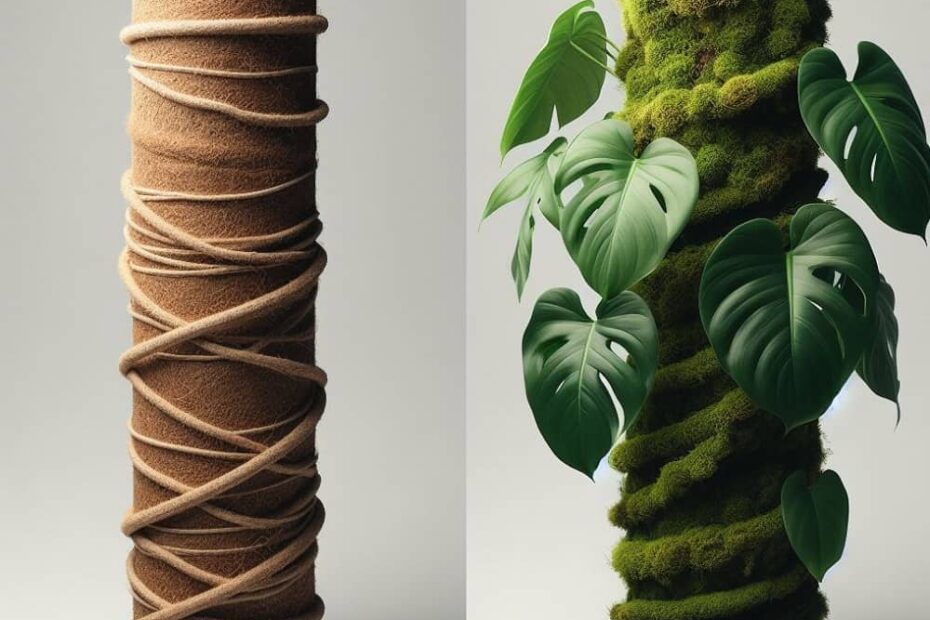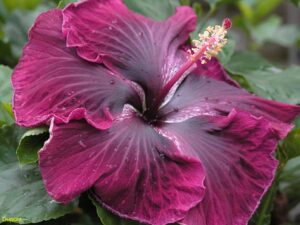Coir Pole vs Moss Pole: The Showdown
When it comes to climbing poles for your indoor plants, there are two main contenders: coir poles and moss poles. Both have their own pros and cons, so which one is right for you?
In this article, we’ll take a closer look at coir poles and moss poles, and we’ll help you decide which one is the best choice for your plants.

We’ll cover everything from the materials used to make each type of pole to the benefits and drawbacks of each. We’ll also provide some tips on how to use each type of pole effectively.
So, if you’re ready to learn more about coir poles and moss poles, read on!
Coir Pole vs Moss Pole: The Showdown
When it comes to supporting climbing plants, there are two main contenders: coir poles and moss poles. Both have their own advantages and disadvantages, so it can be tricky to decide which one is right for you.
Coir Poles
Coir poles are made from coconut fiber, which is a natural and sustainable material. They’re lightweight and easy to set up, and they can be a great option for smaller plants. Coir poles also tend to be more affordable than moss poles.
However, coir poles can dry out quickly, which can make them less effective at supporting climbing plants. They also don’t retain moisture as well as moss poles, so you may need to water them more frequently.
Moss Poles
Moss poles are made from a variety of materials, but the most common is sphagnum moss. Moss poles are heavier and more difficult to set up than coir poles, but they’re also more effective at supporting climbing plants. Moss poles retain moisture well, which helps to keep climbing plants hydrated.
However, moss poles can be more expensive than coir poles. They can also be more difficult to find, especially if you’re not near a specialty gardening store.
Which Pole is Right for You?
Ultimately, the best way to decide which pole is right for you is to consider the needs of your plants.
If you have larger plants or plants that need a lot of support, a moss pole may be a better choice.If you have small plants or plants that don’t need a lot of support, a coir pole may be a good option..
Here is a table summarizing the pros and cons of coir poles and moss poles:
| Feature | Coir Pole | Moss Pole |
|---|---|---|
| Material | Coconut fiber | Sphagnum moss |
| Weight | Lightweight | Heavy |
| Price | Affordable | More expensive |
| Ease of Setup | Easy | More difficult |
| Moisture Retention | Poor | Good |
| Support | Less effective | More effective |
Conclusion
Coir poles and moss poles are both good options for supporting climbing plants. The best option for you will depend on the needs of your plants and your budget.
The Differences Between Coir Poles and Moss Poles
The Differences Between Coir Poles and Moss Poles
When it comes to supporting climbing plants, there are two main types of poles that you can choose from: coir poles and moss poles. Both poles have their own unique advantages and disadvantages, so it’s important to weigh the pros and cons of each before making a decision.
Coir Poles
Coir poles are made from natural coconut fiber, which is a sustainable and biodegradable material. They are lightweight and easy to install, and they can be a good option for small plants or plants that don’t need a lot of support. However, coir poles can dry out quickly, so they need to be watered regularly.
Moss Poles
Moss poles are made from a variety of materials, including sphagnum moss, wood, and bark. They are heavier and more difficult to install than coir poles, but they provide more support for larger plants and plants that need a lot of moisture. Moss poles also retain moisture better than coir poles, so they don’t need to be watered as often.
Which Pole is Right for You?
The best pole for your plant will depend on the size of the plant, the amount of support it needs, and your personal preferences.
If you have a larger plant or a plant that needs a lot of moisture, a moss pole may be a better choice.If you have a small plant or a plant that doesn’t need a lot of support, a coir pole may be a good option..
Here is a table that summarizes the key differences between coir poles and moss poles:
| Feature | Coir Pole | Moss Pole |
|---|---|---|
| Material | Coconut fiber | Sphagnum moss, wood, bark |
| Weight | Lightweight | Heavy |
| Ease of installation | Easy | Difficult |
| Moisture retention | Poor | Good |
| Support | Limited | Good |
| Price | Inexpensive | More expensive |
Ultimately, the best way to decide which pole is right for you is to experiment with different types and see what works best for your plants.
Which Pole is Right for You?
Which Pole is Right for You?
When it comes to choosing a pole for your climbing plants, there are two main options: coir poles and moss poles. Both types of poles have their own advantages and disadvantages, so it’s important to weigh the pros and cons before making a decision.
Coir Poles
Coir poles are made from a natural fiber that is derived from coconut husks. They are lightweight and easy to install, and they can be a good option for beginners who are just starting out with climbing plants. However, coir poles can dry out quickly, which can make them difficult for plants to climb.
Moss Poles
Moss poles are made from a layer of sphagnum moss that is wrapped around a wooden pole. They are more humid than coir poles, which makes them a better option for plants that require a lot of moisture. However, moss poles can be heavier and more difficult to install than coir poles.
Which Pole is Right for You?
The best way to decide which type of pole is right for you is to consider the following factors:
- The size and weight of your plant: If you have a large or heavy plant, you will need a pole that is strong enough to support it.
- The climate in your area: If you live in a dry climate, you will need a pole that can retain moisture.
- Your skill level: If you are a beginner, you may want to choose a coir pole because they are easier to install.
Once you have considered these factors, you can make an informed decision about which type of pole is right for you.
Table of Comparison
| Feature | Coir Pole | Moss Pole |
|---|---|---|
| Material | Coir | Sphagnum moss |
| Weight | Light | Heavy |
| Ease of installation | Easy | Difficult |
| Moisture retention | Low | High |
| Price | Affordable | More expensive |
Coir poles are a popular choice for supporting climbing plants, as they are lightweight, durable, and affordable. However, it is important to care for coir poles properly in order to extend their lifespan and keep your plants healthy.
Here are a few tips for caring for coir poles:
- Water the pole regularly. Coir poles can dry out quickly, so it is important to water them regularly, especially during hot weather. You can either water the pole directly or mist it with a spray bottle.
- Fertilize the pole monthly. Coir poles do not contain any nutrients, so it is important to fertilize them monthly to help your plants grow. You can use a liquid fertilizer or a slow-release fertilizer.
- Repot the pole as needed. Coir poles can eventually break down, so it is important to repot them as needed. You can repot the pole into a larger pot or replace the coir with fresh material.
By following these tips, you can help your coir pole last for many years and keep your climbing plants healthy.
| Tip | Explanation |
|---|---|
| Water the pole regularly | Coir poles can dry out quickly, so it is important to water them regularly, especially during hot weather. |
| Fertilize the pole monthly | Coir poles do not contain any nutrients, so it is important to fertilize them monthly to help your plants grow. |
| Repot the pole as needed | Coir poles can eventually break down, so it is important to repot them as needed. You can repot the pole into a larger pot or replace the coir with fresh material. |
Moss Pole Care Tips
Moss Pole Care Tips
- Keep the moss pole moist. The moss pole should be kept moist at all times, as this will help to keep the roots of your plants healthy. You can mist the moss pole regularly, or you can place it in a shallow dish of water.
- Rotate the moss pole regularly. This will help to ensure that all sides of the moss pole get equal amounts of light.
- Fertilize the moss pole regularly. You can use a diluted liquid fertilizer, or you can apply a slow-release fertilizer to the moss pole.
- Prune the moss pole as needed. This will help to keep the moss pole looking neat and tidy. You can prune the moss pole by removing any dead or damaged leaves.
Here is a table that summarizes the moss pole care tips:
| Tip | Description |
|---|---|
| Keep the moss pole moist | The moss pole should be kept moist at all times, as this will help to keep the roots of your plants healthy. |
| Rotate the moss pole regularly | This will help to ensure that all sides of the moss pole get equal amounts of light. |
| Fertilize the moss pole regularly | You can use a diluted liquid fertilizer, or you can apply a slow-release fertilizer to the moss pole. |
| Prune the moss pole as needed | This will help to keep the moss pole looking neat and tidy. You can prune the moss pole by removing any dead or damaged leaves. |
When it comes to choosing a pole for your climbing plants, there are two main contenders: coir poles and moss poles. Both have their own advantages and disadvantages, so it can be difficult to decide which one is right for you.
Coir Poles
Coir poles are made from coconut husks, which are a natural and sustainable material. They’re also relatively inexpensive, making them a good option for budget-minded gardeners. Coir poles are lightweight and easy to move around, which makes them a good choice for plants that are still small or for plants that you need to repot frequently.
However, coir poles can be a bit messy. The fibers can break down over time, which can release coconut fibers into your soil. This can be a problem if you have plants that are sensitive to moisture, such as orchids.
Moss Poles
Moss poles are made from a variety of materials, but the most common type is made from sphagnum moss. Moss poles are more expensive than coir poles, but they’re also more durable. They’re also less likely to release fibers into your soil, which makes them a good choice for plants that are sensitive to moisture.
Moss poles are heavier than coir poles, so they’re not as easy to move around. However, they’re still relatively lightweight and easy to handle.
Which Pole is Right for You?
Ultimately, the best way to decide which pole is right for you is to consider the needs of your plants. If you have plants that are sensitive to moisture, a moss pole is a good option. If you’re on a budget, a coir pole is a good choice.
Here’s a table that summarizes the pros and cons of coir poles and moss poles:
| Feature | Coir Pole | Moss Pole |
|---|---|---|
| Cost | Inexpensive | More expensive |
| Durability | Less durable | More durable |
| Weight | Lightweight | Heavier |
| Messiness | Can be messy | Less messy |
| Moisture sensitivity | More likely to release fibers | Less likely to release fibers |
The Final Verdict
Coir poles and moss poles are both good options for climbing plants. The best pole for you will depend on the needs of your plants and your budget.
Resources
[1] https://www.thesprucepets.com/coir-vs-moss-poles-591892#:~:text=Coir%20poles%20are%20made%20from,and%20are%20less%20likely%20to
[2] https://www.reptilesmagazine.com/moss-poles-vs-coir-poles-for-climbing-pythons/
In Summary
Coir Pole vs Moss Pole: The Showdown
In the battle of the poles, there is no clear winner. Both coir poles and moss poles have their own unique advantages and disadvantages. Ultimately, the best pole for you will depend on your individual needs and preferences.
If you are looking for a pole that is easy to set up and maintain, then a coir pole may be the best option for you. Coir poles are made from natural materials and are biodegradable, making them a sustainable choice. They are also relatively inexpensive.
However, coir poles can be less stable than moss poles, and they may not be as effective at supporting heavy plants. If you have a large or heavy plant, you may want to consider a moss pole.
Moss poles are made from a variety of materials, including sphagnum moss, coconut fiber, and wood. They are more expensive than coir poles, but they are also more stable and can support heavier plants. Moss poles also create a more natural environment for your plants, as they provide a surface for epiphytes to grow on.
Ultimately, the best way to decide which pole is right for you is to experiment with both types. You may find that one pole works better for some of your plants than others.
- Cat Palm vs Majesty Palm: Which Should You Choose? - June 30, 2024
- Flowers That Survive Winter: Discover the Exceptional No. 5 - June 30, 2024
- The Ultimate Guide to the Growth and Care of the Black Pagoda Lipstick Plant - June 29, 2024





